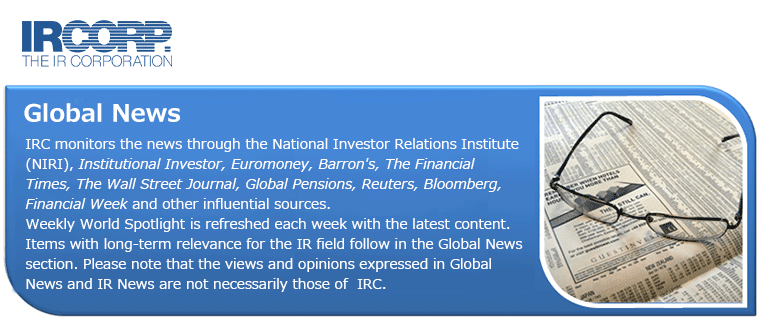Euromoney (March 3)
“At what point does a boom become a bubble? The question needs to be asked in Asian high yield, where year-to-date issuance volumes are fast approaching the figure for the whole of 2016 in China and have already long exceeded it in India and Indonesia – after just eight weeks of the year, one of which was a write-off for Chinese New Year.”
Financial Times (May 20)
“The plunge in yields on corporate and sovereign bonds in Europe and Asia — the value of bonds with a negative yield is nearly $10tn, according to Fitch — has sent investors racing into the US market.” This surging demand “has allowed companies to issue debt at lower yields, though US yields are still more attractive than in other parts of the world.”
Tags: Asia, Bonds, Corporate, Debt, Demand, Europe, Fitch, Investors, Negative yield, Plunge, Sovereign, U.S., Yields
Institutional Investor (May Issue)
“The secret weapon of Abenomics” is the rebalancing of Japan’s Government Pension Investment Fund (GPIF). “The GPIF is diversifying at a pace that’s astonishing for a fund of its size…. In the last six months of 2014, while slashing its JGB holdings, the fund increased its exposure to Japanese stocks by ¥5 trillion, to foreign equities by ¥7 trillion and to foreign bonds by ¥4 trillion.”
Tags: Abenomics, Bonds, Diversifying, Equities, GPIF, Japan, JGBs, Rebalancing, Stocks
The Economist (May 1)
Since 2010, foreign creditors “have extended the equivalent of more than $5 billion of 100-year bonds to Mexico in three currencies: dollars, sterling and now euros.” Moreover, Mexico has received exceedingly good terms (4.2%-6.1%) given its “distinctly spotty credit record.” This speaks volumes about the intensity of the global search for yield, but raises the inevitable question “what are the chances of investors, or their grandchildren, getting their money back?”
Financial Times (January 23)
“It has taken far too long for the European Central Bank to embark on quantitative easing but its belated action is no less welcome.” ECB president Mario Draghi unveiled a massive program to purchase eurozone bonds through 2016 to help counter the threat of deflation. “There is no doubt that Mr Draghi needed to act. Growth and underlying inflation have been relentlessly weak, providing clear evidence that demand in the eurozone is faltering.”
Tags: Bonds, Deflation, ECB, eurozone, Growth, Inflation, Mario Draghi, Quantitative easing
Financial Times (August 1)
“Argentina’s 12-year dispute with a group of hedge funds holding out for full payment on defaulted Argentine bonds is proving to be one of the most wasteful debt restructurings in history…. Indeed the case once again illustrates the need for a better way of managing sovereign defaults.”
Tags: Argentina, Bonds, Debt restructuring, Default, Dispute, Hedge funds, Hold outs, Payment, Sovereign defaults
Washington Post (June 20)
As the Federal Reserve moves closer to an eventual unwinding of its massive quantitative easing program, the dollar looks poised to gain, disadvantaging U.S. exports. “For investors around the world, the great unwinding has begun, with sharp swings in different world bond and stock markets as money is shifted in response to the likelihood of higher interest rates and possibly stronger economic growth in the U.S. Currency markets are moving too – and it may mean a further drag on U.S. exports that are already stuck in neutral.”As the Federal Reserve moves closer to an eventual unwinding of its massive quantitative easing program, the dollar looks poised to gain, disadvantaging U.S. exports. “For investors around the world, the great unwinding has begun, with sharp swings in different world bond and stock markets as money is shifted in response to the likelihood of higher interest rates and possibly stronger economic growth in the U.S. Currency markets are moving too – and it may mean a further drag on U.S. exports that are already stuck in neutral.”
Tags: Bonds, Currency markets, Exports, Fed, Quantitative easing, Stocks, Swings, U.S., Unwinding
The Economist (February 23)
“With short-term interest rates still stuck near zero and their balance-sheets stuffed with government bonds, the central banks of America, Britain and Japan are experimenting with a shift in approach: coupling monetary action with commitments designed to alter the public’s expectations of interest rates, inflation and the economy…. A more doveish stance would entail tolerating higher inflation, at least temporarily, in pursuit of higher output.” But there is “a question-mark over what this wave of central-bank experimentation can achieve: since bond yields are already so low, the marginal return to coaxing them even lower may be scant. For now, though, buoyant stockmarkets are giving the activists the thumbs-up.”
Tags: Bonds, Central banks, Inflation, Interest rates, Japan, Output, Stockmarkets, U.S., UK, Yields
Euromoney (November issue)
“Restrictions and outright bans on short-selling shares, government bonds and credit derivatives were applied across Europe on November 1…. If it is a victory of the European Commission, it is potentially a disaster for Europe’s financial markets. Instead of a positive force for good, as was seemingly intended, negative consequences abound.”
Institutional Investor (August Issue)
With ¥108 trillion in assets under management, Japan’s Government Pension Investment Fund (GPIF) is almost six times the size of CalPERS. “Even more striking than the fund’s gargantuan size is its composition: Fully three quarters of the GPIF is invested in bonds, including ¥58.4 trillion of domestic bonds and ¥14.4 trillion of government agency debt.” This “mountain of government bonds” is “a low-return and potentially high-risk strategy,” and stands in contrast to other pension funds which are “trying to grow their way out by continuing to bet heavily on equities and making ever-larger allocations to private equity, hedge funds, real estate, infrastructure and other illiquid assets.”


